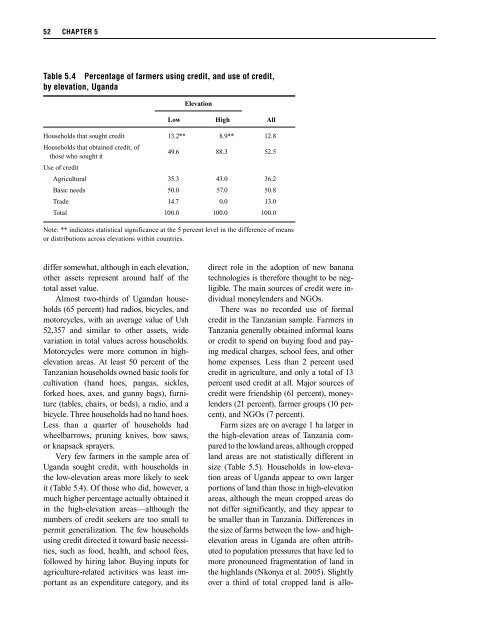An Economic Assessment of Banana Genetic Improvement and ...
An Economic Assessment of Banana Genetic Improvement and ...
An Economic Assessment of Banana Genetic Improvement and ...
Create successful ePaper yourself
Turn your PDF publications into a flip-book with our unique Google optimized e-Paper software.
52 CHAPTER 5<br />
Table 5.4 Percentage <strong>of</strong> farmers using credit, <strong>and</strong> use <strong>of</strong> credit,<br />
by elevation, Ug<strong>and</strong>a<br />
Elevation<br />
Low High All<br />
Households that sought credit 13.2** 8.9** 12.8<br />
Households that obtained credit, <strong>of</strong><br />
those who sought it<br />
49.6 88.3 52.5<br />
Use <strong>of</strong> credit<br />
Agricultural 35.3 43.0 36.2<br />
Basic needs 50.0 57.0 50.8<br />
Trade 14.7 0.0 13.0<br />
Total 100.0 100.0 100.0<br />
Note: ** indicates statistical significance at the 5 percent level in the difference <strong>of</strong> means<br />
or distributions across elevations within countries.<br />
differ somewhat, although in each elevation,<br />
other assets represent around half <strong>of</strong> the<br />
total asset value.<br />
Almost two-thirds <strong>of</strong> Ug<strong>and</strong>an households<br />
(65 percent) had radios, bicycles, <strong>and</strong><br />
motorcycles, with an average value <strong>of</strong> Ush<br />
52,357 <strong>and</strong> similar to other assets, wide<br />
variation in total values across households.<br />
Motorcycles were more common in highelevation<br />
areas. At least 50 percent <strong>of</strong> the<br />
Tanzanian households owned basic tools for<br />
cultivation (h<strong>and</strong> hoes, pangas, sickles,<br />
forked hoes, axes, <strong>and</strong> gunny bags), furniture<br />
(tables, chairs, or beds), a radio, <strong>and</strong> a<br />
bicycle. Three households had no h<strong>and</strong> hoes.<br />
Less than a quarter <strong>of</strong> households had<br />
wheelbarrows, pruning knives, bow saws,<br />
or knapsack sprayers.<br />
Very few farmers in the sample area <strong>of</strong><br />
Ug<strong>and</strong>a sought credit, with households in<br />
the low-elevation areas more likely to seek<br />
it (Table 5.4). Of those who did, however, a<br />
much higher percentage actually obtained it<br />
in the high-elevation areas—although the<br />
numbers <strong>of</strong> credit seekers are too small to<br />
permit generalization. The few households<br />
using credit directed it toward basic necessities,<br />
such as food, health, <strong>and</strong> school fees,<br />
followed by hiring labor. Buying inputs for<br />
agriculture-related activities was least important<br />
as an expenditure category, <strong>and</strong> its<br />
direct role in the adoption <strong>of</strong> new banana<br />
technologies is therefore thought to be negligible.<br />
The main sources <strong>of</strong> credit were individual<br />
moneylenders <strong>and</strong> NGOs. here> 5.4near
















